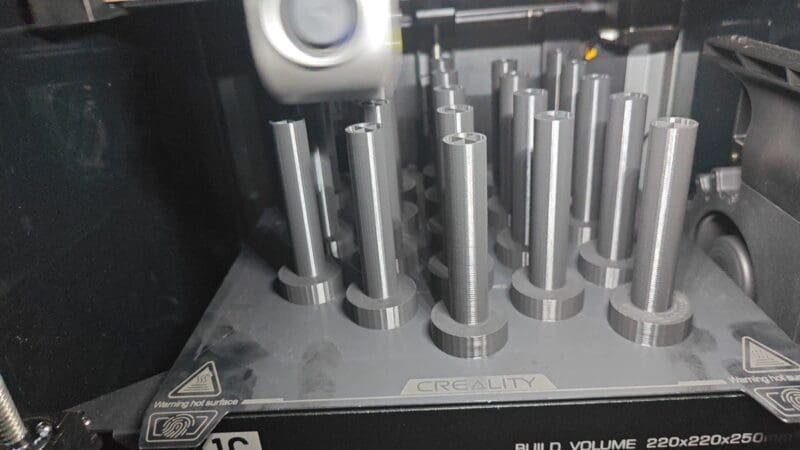Creality K1 vs Bambu Lab P1P: Which 3D Printer is Better?

Recently, I ordered a Creality K1 printer and writing a full review. After publishing my review, I received numerous private messages inquiring about a comparison between the Creality K1 and the Bambu Lab P1P. As a result, this article will highlight the differences I discovered between the two machines, based on my personal testing and the information I gathered.
You may want to read:
Creality K1 3D Printer Review -Worth It Or Not?
The Top 6 Fastest 3D Printers In 2023
Creality K1 vs Bambu Lab P1P
Price
First and foremost, let’s discuss the price. For most people, budget is a primary concern when choosing a 3D printer. The Creality K1 is priced at $599 on the official website and it’s fully enclosed. However, it does not come equipped with a camera or a laser radar, which can be purchased at an additional guess cost of approximately less than $80. (Update: Creality now is having a K1 kit sale campaign which is only $2.99 for a total of an extruder, hotend, AI camera and one hyper filament)Therefore, the total cost to achieve its ultimate performance is less than $650.
If you are interested in getting one, save an extra $25 for the K1 3D with code Welcome50
On the other hand, the P1P is sold with $599 as well as a bare machine, but it comes with a camera and an auxiliary fan. However, it doesn’t have a laser radar. To upgrade the P1P to the ultimate performance, you need to purchase a separate box enclosure for at least $50 and carry out some air venting treatment for about $100. The total cost of the best-performance P1P is around $750.
So we speculate that these two machines will ultimately have a cost difference of around $100.
Printing Speed
When it comes to printing speed, both machines offer similar printing quality and performance. The P1P has a maximum printing speed of 500mm/s, while Creality claims the K1 can reach 600mm/s. However, in testing, both machines operate at a speed of approximately 300mm/s to 400mm/s, with no notable difference in performance.
One of the most significant differentiators between the two machines is the printing area. The P1P offers a visibly larger printing area of 256*256*256, while the Creality K1 offers 220*220*250. Although the vertical height of both machines is similar, there is a gap of 256 in the horizontal direction for the P1P and 220 for the K1.
Apps
Both machines have their own remote control apps allowing users to operate them easily and efficiently over a local network or through 5G technology. Both devices have similar usage environments and ecology. However, the Creality K1 app has more advertisements, including some files from the Creality Cloud. On the other hand, the P1P’s app is user-friendly and only contains the necessary functions required to control the printer.
Easy Of Use
Both printers can be controlled directly from the printer, but the Creality K1 has an advantage in terms of control options because of its touch screen. With just one click, users can control the fan and light, which is especially useful when monitoring the printing process at night. The P1P, on the other hand, has a small touch screen, and it may take multiple clicks to access a function. However, the control options are subjective, and what works for one person may not work for others.
Design
Regarding design, the Creality K1 and P1P are similar in appearance. In terms of hardware, both machines are similar in terms of performance. The P1P boasts a larger and more powerful fan next to the extruder, whereas the K1 has a three-way cooling air duct with a fan blowing from beneath and through three vents. The P1P has an unbalanced design, so an additional fan was added to aid in heat dissipation. However, adding an additional fan to the K1 could result in uneven cooling we guess.
Noise
When using 3D printers, noise levels can be an important consideration depending on where you will be operating the machines. The Creality K1 and P1P are both capable of producing noise, but how much noise they make and how it’s produced differs between them.
The Creality K1 has five different sources of noise when in use, these are the cooling fan, the auxiliary fan, the box fan, the motherboard, and the motor. However, its auxiliary fan power is much larger than the P1P’s, resulting in a noise level of approximately 85 decibels when operational and 68 decibels in a closed-box environment.
Conversely, the P1P produces a noise level of around 75 decibels when the enclosure is open and around 60 decibels when enclosed. The lower noise levels are attributed in part to the P1P’s design, which uses a less powerful auxiliary fan than the K1 but is still effective.
From these comparisons, it’s clear that the P1P produces less noise than the K1. However, it’s also worth noting that whether the noise produced by either printer is objectionable or not depends on the user’s personal preferences and the environment where the printer is being used.
Slicing
After using the Creality and Bambu Lab 3D printers for a few days, we noticed that Creality had made significant improvements to its chip technology and slicing software. The updated software was much more user-friendly but had features from various other slicing software in the market, including Cura and Prusa, making it a bit difficult for new users to navigate at first.
However, it is relatively easy to use once you become familiar with it. Additionally, it is directly compatible with Prusa slicing software, allowing you to slice your model according to your needs and export Gcode straight from Prusa.
On the other hand, Bambu Lab’s slicing software is more refined and precise. Their developers paid attention to every detail, discarding unnecessary elements and optimizing everything that should be kept. Both beginners and experienced users are happy with their software.
Conclusion
We have outlined the pros and cons of both machines and if you have a sufficient budget and want a larger print area, the Bambu Lab P1P is a good option. On the other hand, if you’re a beginner and don’t want to go through too much trouble, the K1 is a great choice. If you’re looking for a high-speed printer with a large printing area, Creality K1 MAX now with a size of 300*300*300 is online as well. This should be great news for those who want a high-speed printer with a large print area.
Where to Buy
DISCLOSURE: THIS POST MAY CONTAIN AFFILIATE LINKS, MEANING I GET A COMMISSION IF you DECIDE TO MAKE A PURCHASE THROUGH MY LINKS, AT NO COST TO YOU. PLEASE READ MY DISCLOSURE FOR MORE INFO.















